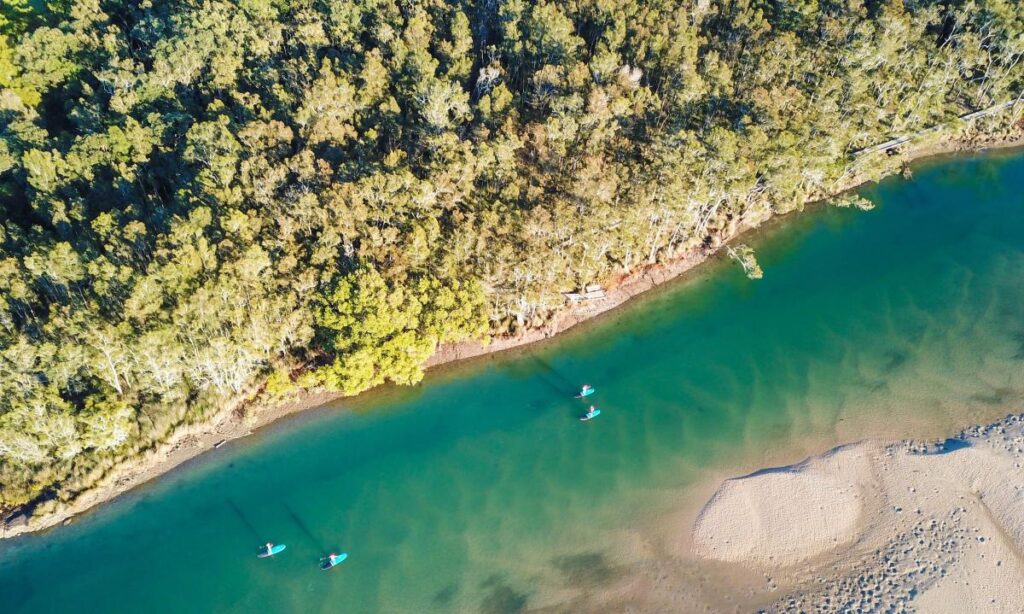Tourism Australia is embracing its rich Indigenous heritage through a variety of cultural experiences that offer insights into the ancient traditions of Aboriginal and Torres Strait Islander peoples. The journey begins in Mossman Gorge, where Kuku Yalanji man Juan Walker conducts a tour that highlights the relationship between his people and the land. Amidst the Daintree Rainforest, participants engage in hands-on activities like clam-digging and learning about the ecological and cultural significance of local flora and fauna. Juan shares ancestral knowledge, emphasizing the interconnectedness of people, nature, and energy, while illustrating how traditional practices and sacred stories have been passed down through generations. His tours not only teach historical survival skills but also promote a deep respect for the environment that First Nations peoples have cultivated over thousands of years. This sense of connection to “Country” serves as a foundation throughout Indigenous-led tourism across the continent.
The thriving Indigenous tourism sector showcases the vibrancy and resilience of diverse communities through immersive experiences. One shining example is found at Uluru, where Aṉangu Elder Rene Kulitja shares her insights as part of the Sunrise Journeys art show hosted by Ayers Rock Resort. This event uniquely combines traditional storytelling with modern technology to create a spectacular visual experience that reveals the beauty of Indigenous culture. With the 40th anniversary of the land’s return to the Aṉangu approaching, the community is committed to sharing their sacred ties to Country and showcasing their way of life through art and activities. The initiative not only highlights Uluru’s cultural significance but also invites visitors to participate in a journey that promotes understanding and appreciation of Indigenous perspectives.
In Perth, Dale Tilbrook of Maalinup Aboriginal Gallery uses food and art to bridge the gap between cultures. As a Wardandi-Bibbulmun woman, Dale employs traditional narratives to educate visitors about local Indigenous history and the impact of colonization. Attendees participate in creative endeavors while simultaneously gaining knowledge of bush food and traditional practices. This approach offers a platform for truth-telling that fosters reconciliation. Similarly, Bundjalung chef Mindy Woods is redefining connections through food in Byron Bay. Her Karkalla On Country lunches incorporate traditional ingredients and cultural experiences, providing attendees a unique opportunity to engage directly with First Nations heritage. Both Dale and Mindy emphasize the importance of education, culture, and community in their initiatives, showcasing how food can be a conduit for connection and understanding.
Further down the coast, Gumbaynggirr man Clark Webb of Wajaana Yaam Adventure Tours utilizes stand-up paddleboarding to blend cultural learning with modern recreation. Clark’s efforts to revitalize the Gumbaynggirr language through his tours illustrate the critical role that tourism can play in preserving Indigenous identities and histories. His bilingual school promotes cultural pride among Aboriginal youth, emphasizing the importance of language for maintaining connections to culture. This approach mirrors the aims of Yura Tours, led by Quandamooka woman Elisha Kissick, who also focuses on cultural preservation while providing ecologically responsible tourism experiences on North Stradbroke Island. Elisha envisions empowering young women in her community through opportunities within the tourism industry, preserving the cultural narratives of her people.
On the rugged Dampier Peninsula, Jawi woman Rosanna Angus’s Oolin Sunday Island Tours create connections through immersive experiences in nature. Rosanna’s focus on storytelling and engagement demonstrates the significance of the landscape to her community. Her belief that being on Country facilitates connections underscores the emotional ties that First Nations peoples have with their homelands. Meanwhile, the GATHAA cultural market in Queensland celebrates First Nations artistry, food, and music, fostering interaction between Indigenous and non-Indigenous Australians. Dale Chapman, who organizes this event, recognizes this market as a platform for sharing diverse Indigenous narratives about culture and heritage.
In urban settings, Indigenous culture is made accessible through restaurants and tours that highlight the evolution of First Nations identity. Nornie Bero’s Big Esso in Melbourne showcases Torres Strait cuisine alongside Indigenous storytelling. Additionally, guided walking tours in Sydney led by Dunghutti-Jerrinjah woman Margret Campbell provide insights into the city’s history through a First Nations lens. With platforms like Tourism Australia’s Discover Aboriginal Experiences, travelers can readily find diverse Indigenous-led experiences. These initiatives invite curiosity about Australia’s Indigenous heritage and foster a more profound understanding of the historical and contemporary realms of First Nations culture, thus ensuring that the narrative of this land and its people is told. Emphasizing stories and connections, Indigenous tourism aims to continue a legacy of sharing and welcoming, ensuring that visitors leave with a newfound respect for the rich traditions of Australia’s First Nations peoples.

